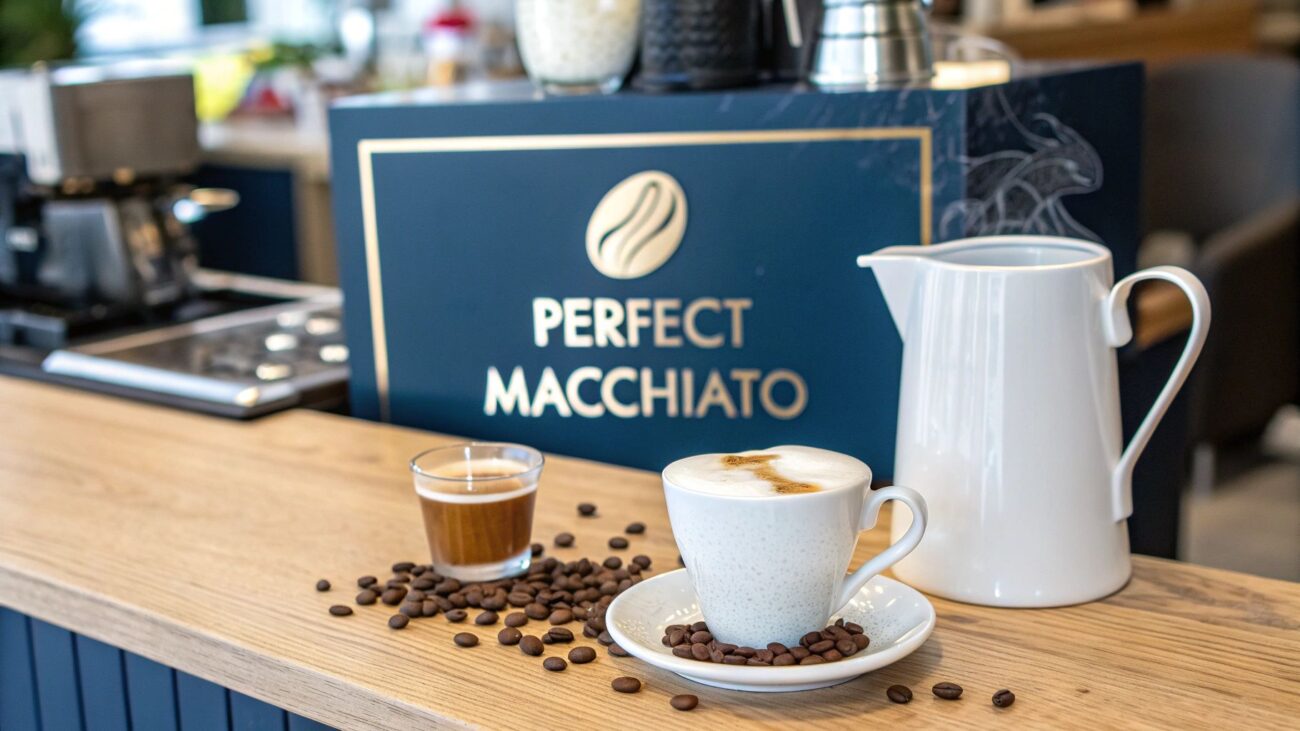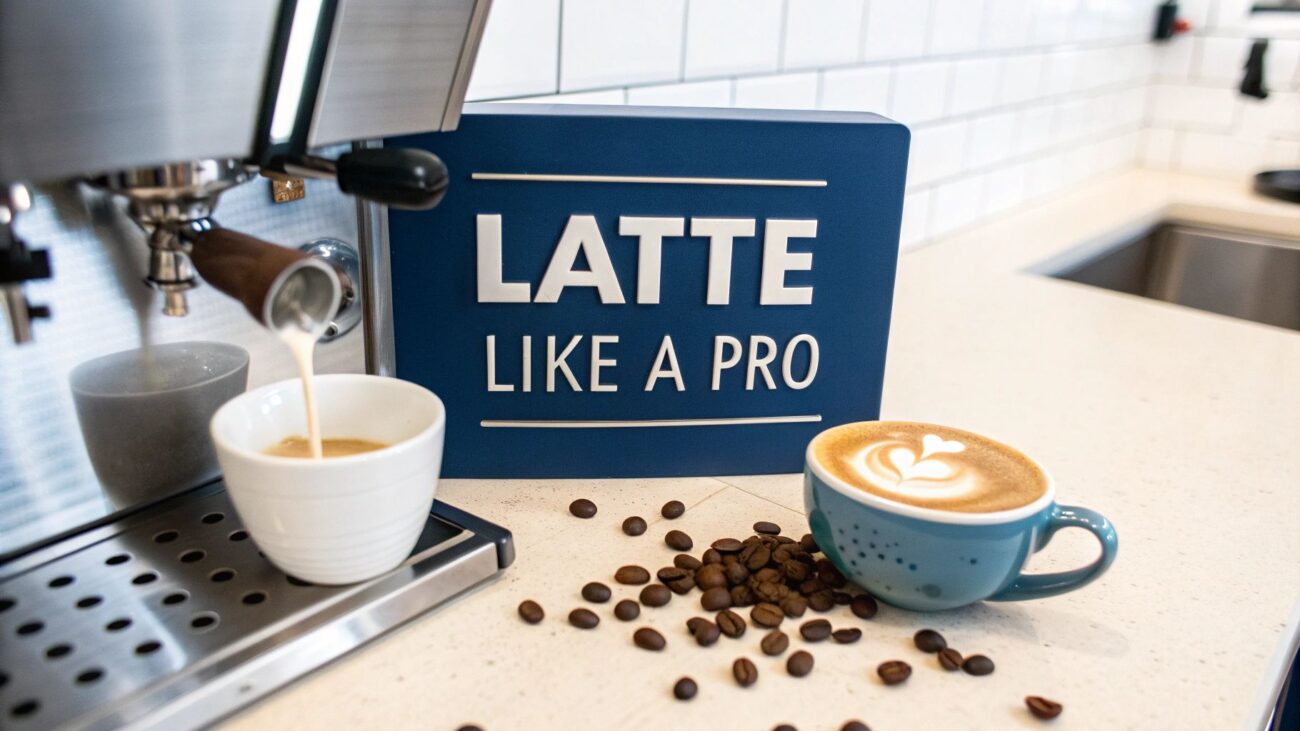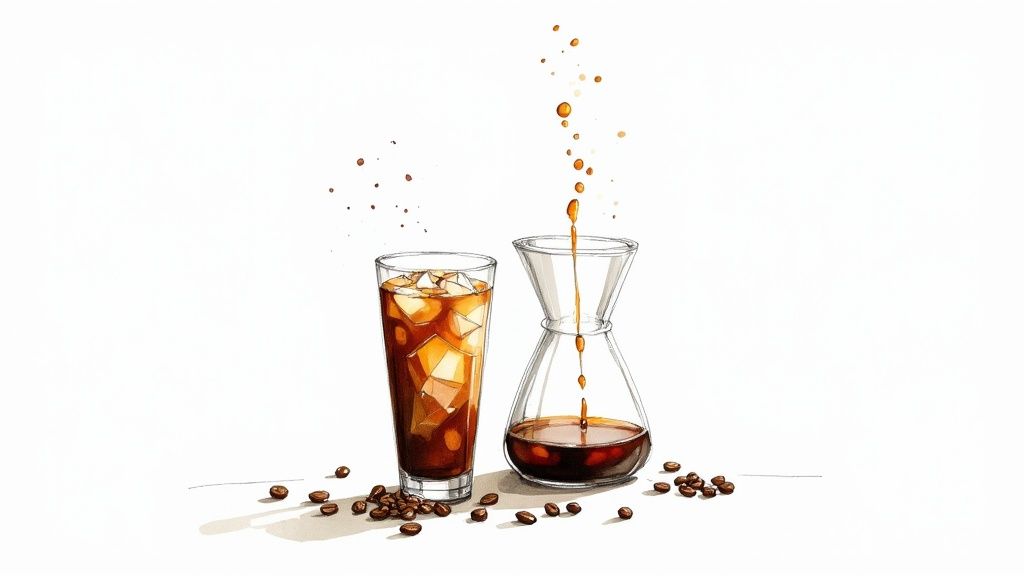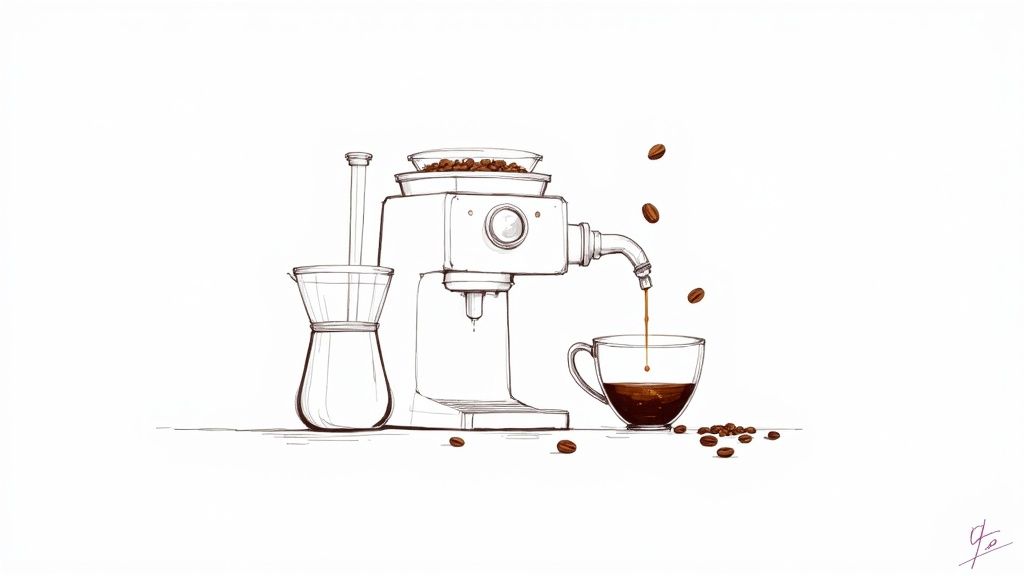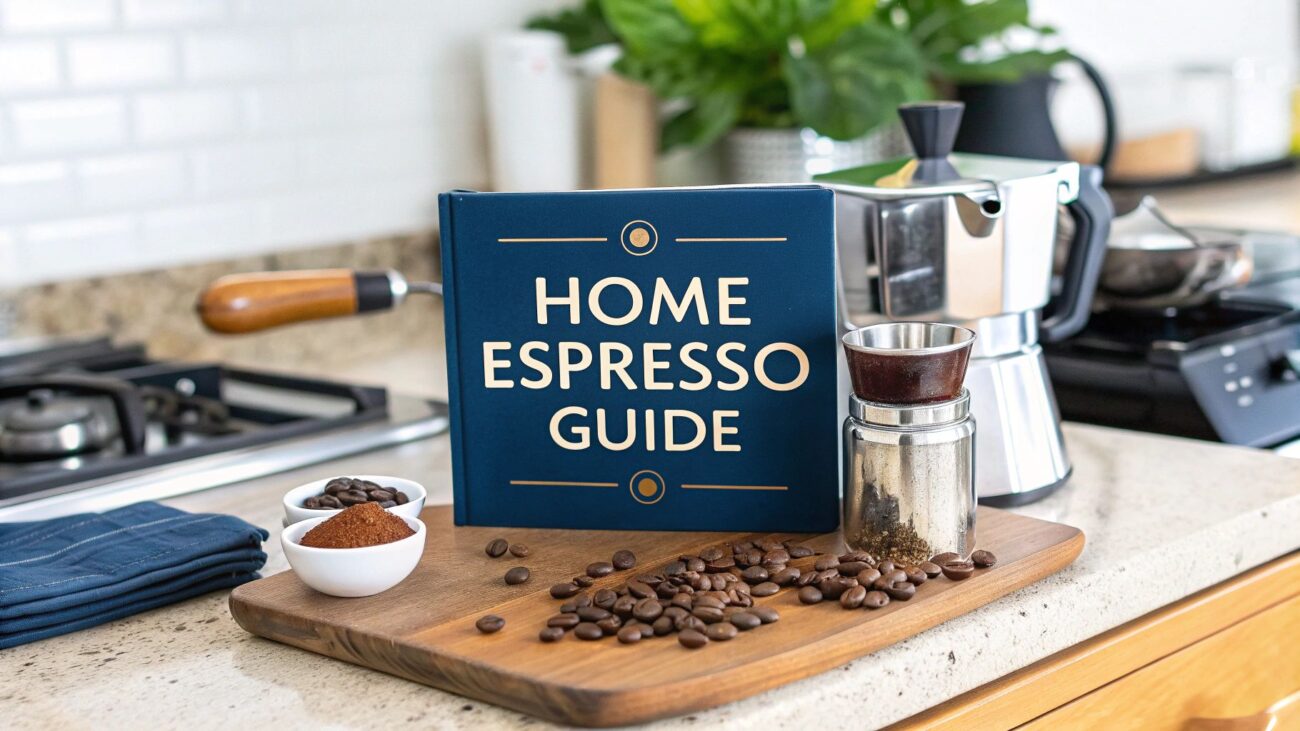Top Coffee Drinks Types You Must Try Today
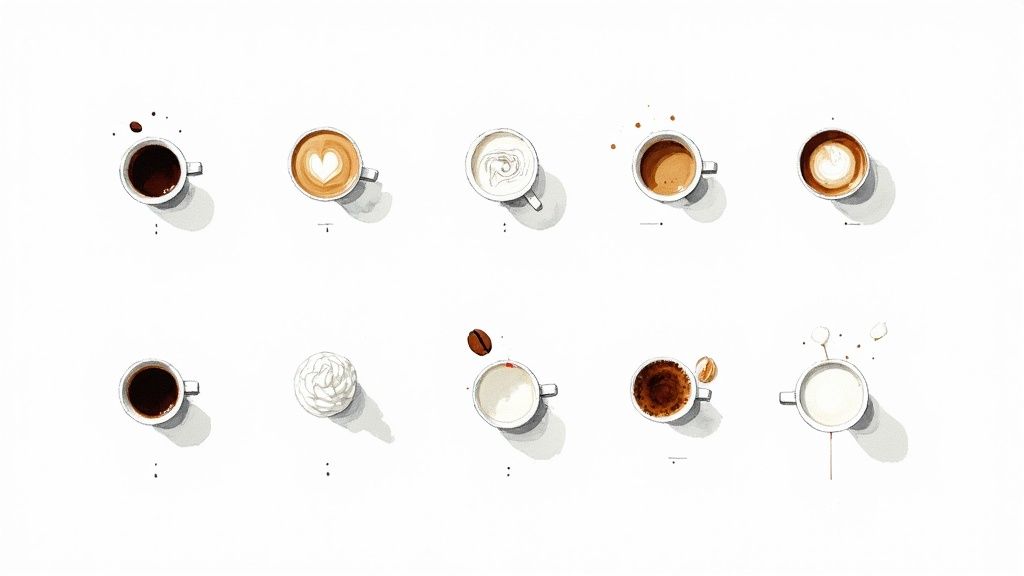
Navigating the world of coffee can be as rich and complex as a perfectly pulled espresso shot. From the intense simplicity of a macchiato to the creamy comfort of a latte, understanding the different coffee drinks types is the first step towards discovering your perfect brew. Whether you're a seasoned coffee connoisseur looking to refine your knowledge or a curious newcomer eager to explore, this guide is designed to be your definitive resource.
We will demystify nine of the most essential and beloved coffee preparations, providing a clear and comprehensive overview of each one. This listicle goes beyond simple definitions. For each drink, we'll break down its core ingredients, explain the specific preparation method, detail its unique flavour profile, and offer serving recommendations so you can enjoy it at its best.
This practical guide is structured to help you order with confidence at any cafe or even begin crafting these delicious beverages in your own kitchen. By exploring this diverse spectrum of tastes and textures, you'll gain a deeper appreciation for the artistry behind each cup. Let's delve into the delightful world of coffee and ensure every future sip is a truly memorable experience.
1. Espresso
Espresso is the heart of many popular coffee drinks and a powerhouse of flavour in its own right. This concentrated beverage is created by forcing hot water at high pressure through finely-ground coffee beans. Originating in Italy at the turn of the 20th century, this method extracts a rich, full-bodied shot topped with a signature reddish-brown foam called crema.
Unlike brewed coffee, espresso is defined by its intense preparation process. This method produces a small, potent serving that captures the pure essence of the coffee bean. It's the foundation for everything from a latte to a flat white, making it one of the most essential coffee drinks types to understand.
Key Characteristics & Preparation
The magic of espresso lies in its precision. The grind size, water temperature, and pressure must be perfectly balanced to achieve a great shot. Modern café culture, from Italian espresso bars to third-wave shops like Blue Bottle, has perfected this art. For those interested in perfecting this technique at home, you can learn more about making espresso.
To achieve that perfect shot, focus on these key factors:
- Fresh Beans: Always use beans roasted within the last few weeks for optimal flavour.
- Consistent Tamp: Apply even, firm pressure when tamping the grounds to ensure uniform water flow.
- Extraction Time: Aim for a "pull" time of 25-30 seconds for a balanced shot.
For a quick reference, the infographic below highlights the core metrics that define a standard shot of espresso.
These metrics show how pressure, volume, and caffeine combine to create the distinctive and powerful experience of a single espresso shot.
2. Americano
The Americano is a beautifully simple coffee drink that offers the aromatic complexity of espresso in a larger, less intense format. It is prepared by diluting a shot of espresso with hot water, resulting in a beverage with a similar strength to traditional brewed coffee but a distinctly different flavour profile. Legend has it the drink was popularised during World War II, when American GIs in Italy added water to local espressos to mimic the coffee they drank back home.
Unlike standard brewed coffee, which involves a longer extraction process, the Americano retains the unique, rich notes of a well-pulled espresso shot. This preparation method makes it a staple in cafés worldwide, from major chains like Starbucks to local independent shops, and a favourite among those who appreciate nuanced coffee drinks types.
Key Characteristics & Preparation
Creating a great Americano is all about the quality of the base espresso and the ratio of water to coffee. The goal is to lengthen the drink without washing out the delicate flavours of the espresso's crema. By adding hot water to the espresso (and not the other way around), you help preserve this signature foam and create a smoother, more balanced cup.
To make a well-crafted Americano, consider these key factors:
- Quality Foundation: Start with a perfectly extracted espresso shot; the final drink can only be as good as its base.
- Correct Ratio: A common starting point is a 1:2 ratio of espresso to water, but feel free to adjust this to your personal preference.
- Water Temperature: Use water that is hot but not boiling (around 85-90°C) to avoid scalding the espresso and altering its flavour.
This method bridges the gap between the intensity of an espresso and the volume of a filter coffee. For those looking to explore different preparation methods, you can learn more about how to brew coffee and compare the results for yourself.
3. Cappuccino
A cornerstone of Italian café culture, the cappuccino is a perfectly balanced and texturally rich coffee drink. It is expertly crafted with equal parts espresso, steamed milk, and a generous layer of thick milk foam. The name is famously linked to the Capuchin friars, whose brown hooded robes mirrored the colour of this classic beverage.
Unlike a latte, which prioritises silky steamed milk, a cappuccino is defined by its distinct, airy foam cap. This frothy layer provides a luxurious mouthfeel and insulates the drink, keeping it warmer for longer. As one of the most iconic coffee drinks types, its global popularity, from traditional Italian bars to major chains like Starbucks, is a testament to its timeless appeal.
Key Characteristics & Preparation
The art of a great cappuccino is in creating the perfect microfoam, which should be velvety and dense rather than bubbly. Achieving this requires precise milk steaming, a skill that baristas in independent coffee shops and competitors in latte art championships have honed. For those making it at home, the key is mastering the steam wand.
To create an authentic cappuccino, focus on these key factors:
- Milk Temperature: Steam the milk to around 65-70°C (150-160°F) to achieve a sweet flavour without scalding it.
- Foam Creation: Keep the steam wand tip just below the surface of the milk to introduce air and build a thick, stable microfoam.
- Correct Ratios: Aim for a 1:1:1 ratio of espresso, steamed milk, and foam to ensure the signature layered texture and balanced taste.
4. Latte
The latte is perhaps one of the most recognised and beloved coffee drinks worldwide, celebrated for its smooth, creamy texture and mild coffee flavour. It consists of a shot of espresso and steamed milk, topped with a thin layer of delicate milk foam. While originating in Italy as a morning beverage, the latte was popularised globally by coffee chains like Starbucks and has become a staple of modern café culture.
Its higher milk-to-espresso ratio makes it an approachable and customisable drink. This versatility has cemented its place as a fundamental offering on nearly every coffee menu, making it one of the most popular coffee drinks types for newcomers and connoisseurs alike. The latte also serves as the perfect canvas for latte art, turning a simple coffee into a visual masterpiece.
Key Characteristics & Preparation
Creating a great latte is all about mastering the milk. The goal is to steam the milk to create a velvety "microfoam," which integrates perfectly with the espresso for a silky-smooth consistency. This is different from the thicker, more distinct foam layer found on a cappuccino. Seasonal variations like the Pumpkin Spice Latte and endless flavour syrup combinations have further boosted its appeal.
To craft the perfect latte at home, focus on these key factors:
- Fresh Beans: The quality of your espresso is crucial, so always start with fresh beans. Understanding how to store coffee beans correctly will preserve their flavour.
- Milk Temperature: Steam your milk to around 65°C (150°F). Overheating can scald the milk and ruin its natural sweetness.
- Pouring Technique: Pour the steamed milk into the espresso in a steady, controlled stream to blend them smoothly and create a base for latte art.
5. Macchiato
The Macchiato is a simple yet elegant espresso-based drink whose name translates from Italian as "spotted" or "marked". It consists of a shot of espresso marked with a small amount of steamed milk or foam. This classic preparation maintains the intensity and rich flavour of the espresso, with just a touch of dairy to soften its edge, offering a bolder experience than a cappuccino or latte.
While many associate the term with the large, sweet drinks popularised by chains like Starbucks, the traditional macchiato is a much smaller, stronger beverage. It is designed for those who find straight espresso a bit too intense but don't want the dilution that comes with a large volume of milk. This drink is a perfect example of how small variations create entirely different coffee drinks types.
Key Characteristics & Preparation
The beauty of a true Macchiato lies in its balance. It’s not about mixing ingredients but about complementing the espresso. The goal is to preserve the complex flavours of the coffee while adding a subtle creaminess. This philosophy is championed in traditional Italian cafés and has been revived by third-wave coffee shops seeking authenticity.
To prepare a classic macchiato, focus on these key factors:
- Minimal Milk: Use only a dollop (one or two teaspoons) of microfoam, not poured steamed milk.
- Espresso Forward: The espresso should remain the dominant flavour. The milk is an accent, not a primary ingredient.
- Proper Serve: A macchiato is traditionally served in a small demitasse or espresso cup (around 3-4 oz).
- No Stirring: The "mark" of foam is intended to sit on top, allowing you to experience both textures as you drink.
These principles ensure the drink remains true to its origins: a beautifully crafted espresso, delicately spotted with milk.
6. Mocha
The Mocha is a delightful marriage of rich coffee and indulgent chocolate, essentially a chocolate-flavoured latte. This popular drink combines a shot of espresso with steamed milk and chocolate, often in the form of syrup or cocoa powder. Named after the historic port of Mocha in Yemen, a city once central to the coffee trade, this beverage has become a global café staple, beloved by those with a sweet tooth.
Unlike more traditional coffees, the Mocha blurs the line between a caffeinated drink and a decadent dessert. Its composition makes it an accessible and luxurious entry point into the world of coffee drinks types, offering a familiar chocolatey comfort alongside the robust kick of espresso. Modern variations, popularised by chains like Starbucks, often come topped with whipped cream and a chocolate drizzle.
Key Characteristics & Preparation
Creating a balanced Mocha is an art that hinges on the quality of its two core ingredients: coffee and chocolate. The goal is to ensure neither flavour overpowers the other, resulting in a harmonious and satisfying blend. Whether you prefer a classic dark chocolate version or a sweeter white chocolate alternative, the key is high-quality ingredients.
To craft a delicious Mocha at home, consider these key factors:
- Quality Chocolate: Use a good quality chocolate syrup, sauce, or real melted chocolate for a richer, more authentic flavour.
- Balance Flavours: Start with less chocolate and add more to taste. The espresso should complement the chocolate, not be completely masked by it.
- Milk Texture: Steam the milk as you would for a latte, creating a smooth, velvety microfoam that mixes perfectly with the espresso and chocolate base.
The Mocha's versatility allows for endless customisation, from using different types of chocolate (dark, milk, white) to adding flavourings like peppermint or caramel, making it a truly versatile and enjoyable coffee treat.
7. French Press
The French Press is a classic immersion brewing method celebrated for producing a full-bodied, rich, and aromatic cup of coffee. This technique involves steeping coarsely ground coffee in hot water before separating the grounds with a metal mesh filter plunger. Originating in France, this method allows the coffee’s natural oils and fine particles to remain in the final brew, creating a uniquely textured and flavourful experience that paper filters often remove.
Unlike methods that rely on quick extraction, the French Press is all about patience and immersion. Its straightforward design, popularised by brands like Bodum, has made it a favourite for home brewing enthusiasts, office kitchens, and even camping trips. Understanding this manual process is key for anyone exploring the diverse world of coffee drinks types, as it highlights how brewing style directly impacts taste and texture.
Key Characteristics & Preparation
The beauty of the French Press lies in its simplicity, but precision is crucial for a perfect brew. The coarse grind prevents sediment from passing through the filter, while the 4-minute steep time extracts a deep, robust flavour. It’s one of the most accessible yet rewarding ways to make high-quality coffee. For those looking to compare it with other techniques, you can explore some of the best coffee brewing methods.
To achieve a consistently excellent brew, focus on these key factors:
- Coarse Grind: Use a burr grinder for a consistent, coarse grind resembling breadcrumbs.
- Water Temperature: Aim for water just off the boil, between 90-96°C (195-205°F), to avoid scorching the grounds.
- Slow Plunge: Press the plunger down slowly and steadily to minimise agitation and prevent fine particles from entering the brew.
- Serve Immediately: Pour the coffee into a cup or separate carafe right after pressing to stop the extraction process and avoid bitterness.
8. Cold Brew
Cold brew offers a uniquely smooth and less acidic coffee experience, making it a favourite for those who prefer a mellow, yet flavourful, cup. Unlike iced coffee, which is typically hot-brewed coffee that has been cooled, cold brew is created by steeping coarsely ground coffee beans in cold or room-temperature water for an extended period, usually 12 to 24 hours. This slow, gentle extraction process yields a rich concentrate with a naturally sweet taste and a smooth finish.
This method, popularised by third-wave coffee pioneers like Stumptown and Blue Bottle, has become a staple in cafés and homes alike. Its low acidity and smooth profile make it one of the most refreshing and approachable coffee drinks types available, perfect for a hot day or for those with sensitive stomachs.
Key Characteristics & Preparation
The secret to great cold brew lies in patience and proportion. The long steeping time allows the water to gently extract the coffee’s complex flavours without the bitter compounds that hot water can release. If you're looking to create this smooth beverage at home, you can learn more about making your own cold brew coffee.
For a perfect batch, focus on these key factors:
- Coarse Grind: A coarse grind is essential to prevent over-extraction and a cloudy final product.
- Coffee to Water Ratio: Start with a 1:4 ratio of coffee to water to create a strong concentrate that can be diluted later.
- Strain Thoroughly: Filter the coffee at least twice through a fine-mesh sieve or cheesecloth for maximum clarity and a grit-free texture.
The resulting concentrate can be stored in the refrigerator for up to two weeks and is ready to be mixed with water, milk, or served over ice.
9. Turkish Coffee
Turkish coffee is an ancient and culturally significant preparation method, recognised by UNESCO as an Intangible Cultural Heritage of Turkey. This unfiltered drink is made by simmering extra-finely ground coffee beans with water and often sugar in a special pot called a cezve or ibrik. The result is a strong, thick, and aromatic brew that is deeply intertwined with tradition and hospitality.
Unlike filtered coffee, the grounds remain in the cup, settling at the bottom to form a thick sediment. This method produces a uniquely rich flavour and velvety texture, making it a standout among the world's coffee drinks types. From traditional Turkish households and Middle Eastern restaurants to speciality coffee demonstrations, its preparation is a celebrated ritual.
Key Characteristics & Preparation
The art of Turkish coffee lies in its slow, deliberate heating process, which develops a signature foam on top. The quality of this foam is a mark of a well-prepared brew. Its thick, almost syrupy consistency and intense flavour profile offer a coffee experience that is both a beverage and a cultural ceremony.
To master this historic method, consider these essential tips:
- Slow Heat: Gently heat the cezve to encourage a rich foam to build without boiling over.
- Add Sugar Early: If you prefer it sweet, add sugar to the water and coffee grounds before heating.
- Spice It Up: A pinch of cardamom can be added during brewing for a traditional, aromatic twist.
- Serve with Water: It is customarily served with a glass of water to cleanse the palate before sipping.
The video below demonstrates the traditional technique for brewing authentic Turkish coffee.
This careful process, passed down through generations since the Ottoman Empire, showcases how history and flavour can be brewed together in a single small cup.
Comparison of 9 Popular Coffee Drink Types
| Coffee Type | Implementation Complexity 🔄 | Resource Requirements ⚡ | Expected Outcomes 📊 | Ideal Use Cases 💡 | Key Advantages ⭐ |
|---|---|---|---|---|---|
| Espresso | High – requires precise pressure & grind | High – expensive machines, fine grind | Strong, concentrated shot with rich crema | Quick, intense coffee; base for many drinks | Intense flavour; quick preparation; rich crema |
| Americano | Moderate – dilute espresso with hot water | Medium – needs espresso machine + water | Similar strength to drip coffee, less intense | Those wanting milder espresso flavour; customisable | Less intense; familiar taste; flexible |
| Cappuccino | High – requires skilful milk steaming | Medium-High – espresso machine + steam wand | Balanced coffee + milk with creamy microfoam | Traditional morning drink; those seeking creamy texture | Perfect flavour balance; creamy texture; latte art |
| Latte | High – requires quality milk steaming | Medium-High – espresso machine + milk steamer | Smooth, mild coffee with more milk | Coffee novices; flavoured/custom drinks; iced versions | Very approachable; great for customisation; creamy |
| Macchiato | Moderate – espresso "marked" with small milk | Medium – espresso machine + small milk amount | Strong espresso with minimal milk | Espresso lovers wanting slight milk softening | Strong flavour; low milk/calories; quick prep |
| Mocha | High – combines espresso, steamed milk, chocolate | Medium-High – espresso machine + chocolate | Sweet, chocolate-flavoured coffee drink | Dessert-style coffee; chocolate lovers | Sweet & customisable; bridges coffee & chocolate |
| French Press | Low – simple immersion brewing | Low – inexpensive press & coarse grounds | Full-bodied, textured coffee with sediment | Manual brewing at home, office, or camping | Rich flavour; inexpensive; eco-friendly |
| Cold Brew | Low-Moderate – long steeping, coarse grounds | Low – coarse grounds & cold water | Smooth, less acidic concentrate, served cold | Hot weather; batch brewing; mellow flavour | Smooth taste; less acidic; long storage |
| Turkish Coffee | High – slow heating in cezve, very fine grind | Medium – special pot, extremely fine grind | Strong, unfiltered coffee with grounds settled | Cultural/traditional settings; social experiences | Rich tradition; unique flavour; customisable sweetness |
Finding Your Perfect Cup
Our journey through the diverse world of coffee drinks types has revealed a remarkable spectrum of flavours, textures, and traditions. We’ve moved from the foundational, potent shot of an espresso to the smooth, low-acidity profile of a cold brew, and from the frothy, balanced comfort of a cappuccino to the historic, unfiltered richness of Turkish coffee. The key takeaway is clear: there is no single "best" coffee drink, only the one that is best for you in a particular moment.
Understanding the fundamental differences between these preparations empowers you to make more informed and enjoyable choices. The distinction is often in the details: the ratio of espresso to milk, the texture of the foam, the temperature of the water, and the brewing time. A latte offers a milky, gentle start to the day, whereas a macchiato provides a bold, espresso-forward kick with just a hint of creaminess. Recognising these nuances transforms you from a passive consumer into an active participant in your coffee experience.
Your Next Steps in Coffee Exploration
So, where do you go from here? The most valuable action you can take is to step outside your coffee comfort zone. Think of this article not as a definitive list, but as a map for your future brewing adventures. Here are some practical steps to continue your exploration:
- Become a barista at home: Choose one drink from this list that you’ve never made before, like a French press or a traditional mocha. Research the specific technique, get the right grind, and experiment with the process. Mastering a new method is incredibly rewarding.
- Order strategically: The next time you visit your favourite coffee shop, consciously order something different. If you always get an Americano, try a cappuccino. If you’re a dedicated latte drinker, ask for a classic macchiato to appreciate the pure flavour of the espresso.
- Pay attention to the bean: Realise that the base ingredient, the coffee bean itself, is the most critical variable. The same cappuccino recipe will taste vastly different when made with a bright, fruity single-origin Ethiopian bean versus a rich, chocolatey Brazilian blend. This is where your coffee journey truly deepens.
Embracing this variety is not just about tasting different drinks; it’s about appreciating the incredible versatility of the coffee bean and the rich cultural history behind each preparation method. By experimenting, you’ll not only discover new favourites but also develop a more sophisticated palate, enabling you to identify the specific notes and characteristics you truly enjoy. This knowledge elevates a simple daily routine into a mindful, flavourful ritual.
Ready to put your newfound knowledge into practice? The quality of your beans is the foundation of any exceptional coffee drink. At Seven Sisters Coffee Co, we meticulously source and roast premium beans using our signature oxygen-free process to preserve their unique flavour profiles. Explore our collection at Seven Sisters Coffee Co to find the perfect single-origin or artisanal blend for your next brewing adventure.






